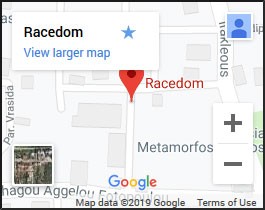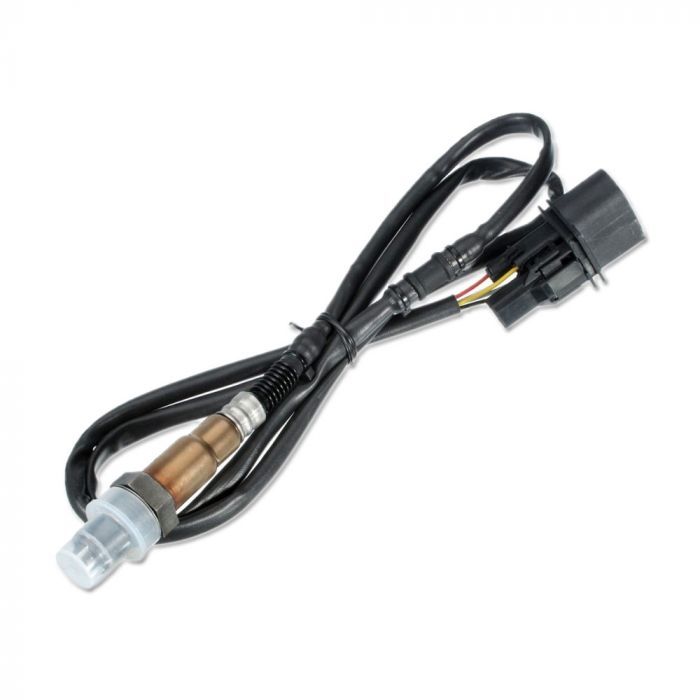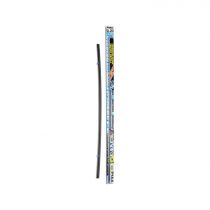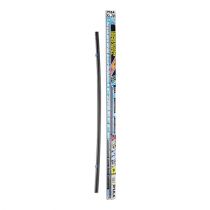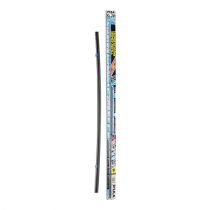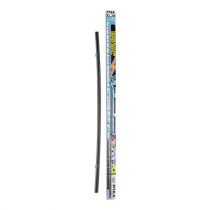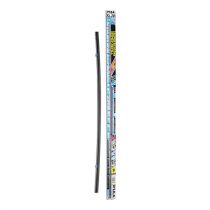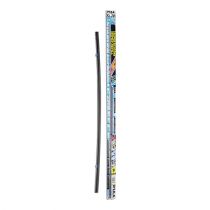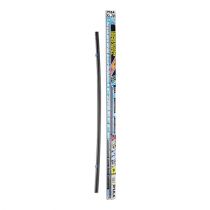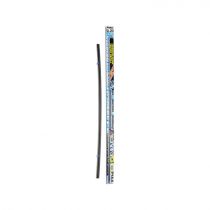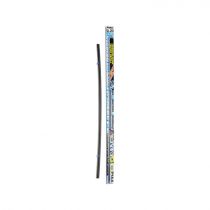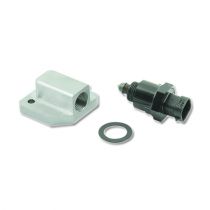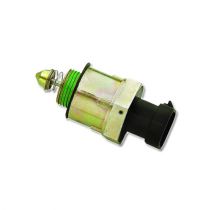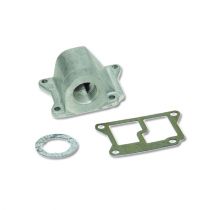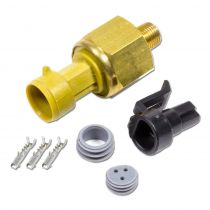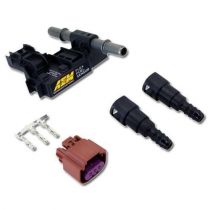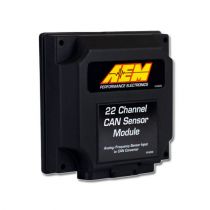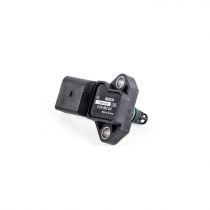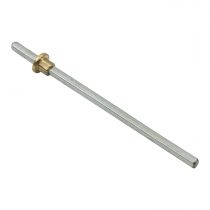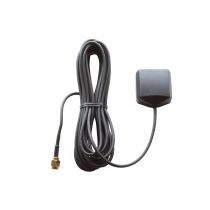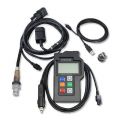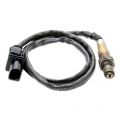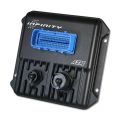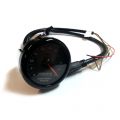Innovate Wideband Lamda Sensore (Bosch LSU 4.2)
Bosch LSU4.2 Sensore O2 a 5 fili e larga. Sensore di sostituzione per LM-1, LM-2, LC-1, LC-2 e LC-1ST. Lunghezza del cavo: 60 cm. Nessuna garanzia per il sensore lambda **
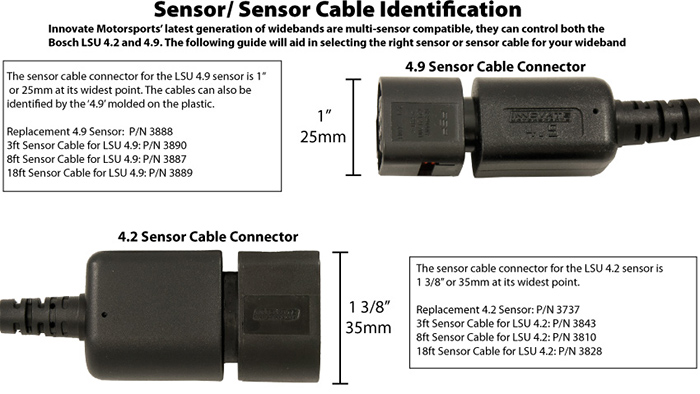
Attenzione!
Questo sensore NON ha garanzia nel caso in cui lo utilizzi o lo installi.
Si prega di provare il sensore prima di installarlo. Nel caso in cui si riscontri che il sensore non funziona correttamente, si prega di contattarci il prima possibile.
Corretta installazione del sensore Lambda.
Al fine di far durare più a lungo il sensore, è necessario conoscere quanto segue:
- Il sensore non dovrebbe mai essere installato sullo scarico senza alimentazione nel caso in cui il motore sia in funzione.
- La distanza ideale di installazione del sensore a valle è appena prima del catalizzatore.
- If the installation position is no more 50cm from the downstream please use a special bung to remove heat.
- Se il motore sta lavorando con una temperatura EGT elevata (superiore a 800C) come i motori turbocompressi. Dovresti installare il sensore almeno a 60 cm a distanza a valle e utilizzare un bocchettone speciale per rimuovere il calore.
- Per evitare la raccolta di liquidi tra questa custodia del sensore e l'elemento del sensore durante la fase di avvio a freddo, l'angolo di installazione dovrebbe essere inclinato almeno di 10 gradi verso l'orizzontale con il connettore elettrico rivolto verso l'alto.
Riferimento incrociato - Numeri di parte equivalenti
- Bosch 17014
- LSU 4.2
- 5 Sonda lambda a banda larga con 5 fili
- Bosch OE # 0 258 007 057 ( 0258007057)
- Volkswagen # 021-906-262B
- Innovate Motorsports # 3737
- PLX Dispositivi # Tipo A
- Accel DFI # 77061
The art of tuning an engine is not new, dating back to the birth of the internal combustion engine over 100 years ago. For a generation or two, methods such as vacuum gauges, CO meters, and the black art of reading spark plugs were the main tools in a tuners arsenal. Due to the lack of accuracy of these methods, tuning was nothing more than subjective analysis and best left to the seasoned professional.
Later, as emissions standards tightened and as racing engines started to produce higher and higher outputs, the need to accurately determine air-fuel ratio became increasingly important. Technology improved and wide band air fuel ratio meters with embedded data logging equipment emerged. For many years this technology was out of reach for all but the most well heeled DIY tuner. The cost of accurate reference level wideband air fuel ratio meters was in the several thousand dollar range.
The affordable meters on the market, at the time, used conventional narrow band O2 sensors- the same type of sensors found in most early EFI cars. Such sensors are only accurate around the stoichiometric range, which is an air fuel ratio of 14.7:1. Accuracy in this range is useless for performance tuning where wide-open throttle ratios may drop as low as 11:1, and certainly in the 13:1 range for most naturallyaspirated engines.
The big breakthrough for the performance aftermarket occurred when Bosch made the LSU4 wide band O2 sensor available for a reasonable price, and the aftermarket responded by making affordable wide band air fuel ratio meters using this sensor. This is a boon to the DIY tuner as now there are many wideband air fuel ratio meters available on the market for a reasonable price.
Not All are Equal
Many questions have arisen since the widespread availability of wideband air-fuel meters.
First, since all of these meters use the same Bosch sensor, and since this sensor is factory calibrated, are they all more or less equal? The answer is no. There is significant difference between the controllers and circuitry used in the various meters. How the sensor's heater is controlled and how the pump current is switched and controlled, for instance, are critical for accurate sensor operation. Other questions also can be posed: Which meter is the best performing one? Which meters have the features I need?
With these question and few subjective answers to be found, we set out to determine which meters were the best. The task was a difficult one but we were determined to find the answers.
Methodology
The plan was to take eight popular units and test them right out of the box using calibrated compressed gas. We'd then run them for an hour on a test engine, with leaded race fuel, to simulate wear on the sensor. Finally we'd test them again with calibrated lab gas. The compressed gas is from Scott Specialty Gasses and formulated to SAE standards for .8 lambda and .895 lambda (11.76 AFR and 13.15 AFR respectively). The gas gives us a control with which we can test each sensor without introducing variability - such as a change in rpm if we were to use the test engine's exhaust gas. To further control the study we used Westech's expensive ECM LambdaPro which read dead-on for both of the gas controls.
1. Sensors were tested using laboratory gas specifically formulated to yield 11.76 AFR and 13.15 AFR. This way each sensor sees the exact same "exhaust gas", letting us measure the accuracy and responsiveness of each meter.
2. After testing with lab gas the sensors were run-in for an hour with race fuel, on a test engine (Westech just happened to have a Chevy motor in the dyno room that day.) The run in simulates the wear and tear a sensor goes through with live fuel and heat conditions.
3. Nine bungs were welded into the exhaust; eight for the sensors under test and one for Westech's own meter. Datalogging was performed during the engine run-in to assess the capabilities of each meter.
4. A common power and ground supplied each meter to ensure no other variables influenced the testing.
During the dyno testing, we also logged data from all of the units. This gave us a chance to configure each unit's analog outputs, and to compare response time (latency) and accuracy under various loads, sweeps, and conditions. We also verified that the logged data matched the values displayed on the various gauges and displays. All the units shared a common and robust power and ground setup.
The chart on the following page summarizes our findings across four categories. Of particular note was the issue of re-calibration. All of the units certainly rely on the factory calibration of the sensor from Bosch. The manufacturers may even perform some sort of a calibration of the sensor to their units during their assembly process. However, as far as we could tell, only two units appeared to be capable of re-calibration to compensate for sensor wear. The Innovate unit is self calibrating, while the NGK requires the user to turn a knob until the display reads "CAL." Both measure the air-fuel ratio of free air to calibrate the sensor.
This raised the obvious question: If a unit is not capable of calibration, how does the user know when the sensor is going bad? We know from the Bosch data that the sensors themselves change as they age.
As previously discussed, air/fuel data is most useful when correlated with other key parameters like throttle position, manifold absolute pressure, and RPM. And this sort of correlation absolutely requires data logging. So, even though all of these units feature useful real-time displays, the most important parameters are response time and the quality of the logging solution. Response time is critical because it's possible to have accurate data, but, due to high latency/delay, the data is essentially in the wrong column of your fuel map.
Results - At a Glance
Listed below, from A to Z, are the eight meters we tested. All use the Bosch LSU4 wideband oxygen sensor. There was a surprising amount of variation between the various units, in terms of both accuracy and response time. We also rated the ease of use, display, and included software. The participants were AEM, Dynojet, FAST, FJO, Innovate, NGK, PLX, and Zeitronix.
AEM
The AEM unit was accurate during our tests, but with no real data logging capability, of limited usefulness for actual tuning. It was average for response time.
AFX (NGK)
The NGK unit exhibited low scores for accuracy, and it was missing the required wire for analog output. It does not have data logging capabilities. Considering NGK makes their own wideband sensors, it is a surprise this unit ships with a Bosch sensor.
Dynojet
The Dynojet unit was hard to set up, and the included logging software was very limited. The Dynojet exhibited the slowest response time tested.
FAST
The FAST unit had internal datalogging, but no separate logging analysis software. This perhaps makes it less useful for complex tuning, but is really "to the point" for those wanting no-frills wideband tuning. Setting up the analog outputs was somewhat difficult. Display is nice and intuitive.
FJO
The FJO unit had tricky wiring for the sensor, the controller, and the analog outputs. It was also difficult to setup the analog outputs with the included configuration software. The included logging software was counterintuitive.
Innovate
The Innovate unit was accurate, exhibited the fastest response time, and included very good analysis software. Innovate claims to be the only truly digital unit, and the high accuracy and low latency seem to support their claims. Setup and wiring was complex and somewhat confusing.
PLX
The PLX M300 does not include logging software, and exhibited accuracy at +/1 AFR (the worst tested). Note that PLX has commented below, and believes we did not wire their unit properly in that we used a common ground for all units.
Zeitronix
The Zeitronix exhibited accuracy of +/- .54 AFR, and gradual lean drift under some conditions. The included logging software was relatively difficult and lacked features. Note that Zeitronix indicated we may have reviewed an outdated unit (see comments below.)
The only regret we have is that we couldn't effectively simulate long-term sensor "aging." Aging is mostly due to oxidation of the sensors internals and fouling of its ceramic elements. Operating conditions and fuel type are big factors in the aging process. Exposure to lead in race gas, metallic elements in octane booster additives, oil or carbon fouling and really high operating temperatures contribute to rapid aging, and a resulting loss of sensor accuracy. Because of aging it is important to have an air fuel ratio meter that can be calibrated. The common type of calibration is called a free air calibration. This is when the meter compares the output of the sensor to what it should be when exposed to a know oxygen content gas, air. If an air fuel ratio meter is lacking the ability to calibrate, the sensor should be replace at regular intervals. The trouble is when should the sensor be replaced? It takes some experience to know when this is appropriate.
We did try to emulate this idea using a variety of old and damaged sensors we had laying around. With one of these sensors, the Innovate XD-16 would show an error code indicating that the sensor was bad. However, when we connected the same damaged sensor to any of the analog gauges they read as much as 3 AFR off. Again, the obvious question is: If your gauge can't tell you when a sensor is bad, how could you ever trust it?






















